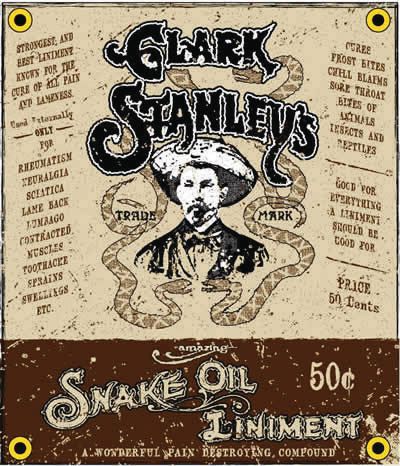Joint Lubricant
Evan Zabawski | TLT From the Editor September 2014
‘Snake oil’ or actual snake oil?

This idea of a snake oil salesman is mostly based on a real-life Texan cowboy named Clark Stanley.
WHENEVER I AM ASKED FOR AN OPINION regarding an aftermarket lubricant or fuel additive, the question is invariably phrased, “So does Product X work, or is it just snake oil?” The insinuation is that the product is sold with deceptive demonstrations and is either ineffectual or has the potential to do more harm than good, but is that really true of snake oil?
The construction of the First Continental Railroad from 1863 to 1869 utilized thousands of Chinese workers who came to North America during the Gold Rush in the mid-1800s. Among the few possessions they brought with them was snake oil, made from the oil of the Chinese water snake. This oil is rich in omega-3 fatty acids that help to reduce inflammation and was used to treat arthritis, bursitis and other joint pains. The Chinese workers would rub this centuries-old remedy on their joints after a grueling day at work and even share it with their American counterparts.
Not only does this remedy work as a form of joint lubricant that helped loosen stiff joints, it has the added effect of lowering blood pressure, too. Looking to capitalize on the growing popularity and dwindling supply, hucksters would begin concocting their own variants and traveled from town to town pushing their eponymous elixir.
Our vision of this practice comes from the old cowboy movies where we would see a man with his horse and wagon, laden with bottles of medicine, arrive into town. After he stops his wagon in a central area with people milling about, he would climb up on a perch, such as his wagon seat, and loudly introduced himself as Dr. So-and-So (most often a bogus credential). He would begin extolling the virtues of his patent medicine that promised to cure pains, indigestion, skin rashes, baldness and many other common ailments (even removing stains!). With a lot of showmanship, a non-stop pitch and sometimes a plant to shill, he would sell bottles to the masses and then ride off to his next group of unsuspecting folk before any of the people got a chance to evaluate their purchase.
This idea of a snake oil salesman is mostly based on a real-life Texan cowboy named Clark Stanley, the self-styled “Rattlesnake King.” Stanley claimed to have spent more than two years learning about the healing power of rattlesnake oil from Hopi medicine men. He began selling his product in 1879 and became a hit attraction at the Chicago World’s Fair in 1893 when he “reached into a sack, plucked out a snake, slit it open and plunged it into boiling water. When the fat rose to the top, he skimmed it off and used it on the spot to create Stanley’s Snake Oil, a liniment that was immediately snapped up by the throng that had gathered to watch the spectacle.”
There were only two problems with Stanley’s claim about his oil. First, is that rattlesnake oil has about one-third of the vital fatty acids as Chinese water snake oil. Second, was that his liniment didn’t even contain snake oil. The Pure Food and Drug Act of 1906 sought to clamp down on the sale of such patent medicine, and it was this legislation that ultimately led to his undoing.
In 1917, federal investigators seized a shipment of Stanley’s oil. The analysis showed it was mostly mineral oil, about 1 percent fatty oil that was believed to be from beef fat, some red peppers for soothing warmth and traces of camphor and turpentine for the medicinal smell. Stanley’s signature product was a complete scam, so he was fined $20 for misbranding his product by falsely and fraudulently representing it as a remedy for all pain. Stanley did not dispute the charges and the term snake oil soon became symbolic with fraud.
 Evan Zabawski, CLS, is the senior reliability specialist for Fluid Life in Edmonton, Alberta, Canada. You can reach him at evan.zabawski@fluidlife.com
Evan Zabawski, CLS, is the senior reliability specialist for Fluid Life in Edmonton, Alberta, Canada. You can reach him at evan.zabawski@fluidlife.com.